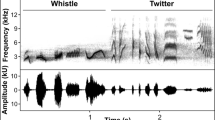Abstract
Males of tuco-tucoCtenomys talarum Thomas, 1898 use particular burrow’s entrances to emit their territorial vocalization. Therefore we studied the internal structure of these entrances and the possible effect on the emission and propagation of airborne sounds. Externally, the burrow entrances used by tuco-tucos males to vocalize were characterized by the absence of sand mounds around their openings. Internally, most of the burrow’s entrances consisted of a main, relatively straight, tunnel of 30–40 cm length, with a diameter of 5.7–6.4 cm. After passing through the burrow’s entrance, the low-frequency components of an artificial signal played back inside the tunnel were not only less attenuated but also amplified (measured at 10–30 cm from the burrow opening). Therefore, the emission of territorial vocalizations inside the particular burrow’s entrances may be considered as a complex adaptative behavior, in which burrow structure improves the signal emission and propagation. Moreover, this work also showed thatC. talarum’s territorial vocalization seems to be adequate for long, inter-burrow communication, since its physical characteristics (high amplitude and low main frequency) are concomitant with the frequencies that are better transmitted in the natural habitat of this species of subterranean rodent.
Similar content being viewed by others
References
Antinuchi C. D. and Busch C. 1992. Burrow structure in the subterranean rodentCtenomys talarum. Zeitschrift für Säugetierkunde 57: 163–168.
Bailey W. J., Bennet-Clark H. C. and Fletcher N. H. 2001. Acoustic of a small Australian burrowing cricket: the control of low-frequency pure-tone songs. Journal of Experimental Biology 204: 2827–2841.
Begall S., Lange S., Schleich C. E. and Burda H. 2007. Acoustic, Audition and Auditory System. (In: Subterranean Rodents, News from Underground. S.Begall, H. Burda and C. E. Schleich, eds). Springer Berlin Heidelberg: 113–125.
Busch C., Malizia A. I., Scaglia O. A. and Reig O. A. 1989. Spatial distribution and attributes of a population ofCtenomys talarum (Rodentia: Octodontidae). Journal of Mammalogy 70: 204–208.
Busch C., Antinuchi C. D., Del Valle J. C., Kittlein M. J., Malizia A. I., Vassallo A. I. and Zenuto R. R. 2000. Population ecology of subterranean rodents. [In: Life underground. E. A. Lacey, J. L. Patton and G. N. Cameron, eds]. University of Chicago Press, Chicago: 183–226.
Calder W. A. 1990. The scaling of sound output and territory size: are they matched? Ecology 5: 1810–1816.
Credner S., Burda H. and Ludescher F. 1997. Acoustic communication underground: vocalizations characteristics in subterranean social mole-rats (Cryptomys sp., Bathyergidae). Journal of Comparative Physiology A 180: 245–255.
Francescoli G. 1999. A preliminary report on the acoustic communication in UruguayanCtenomys (Rodentia: Octodontidae): Basic sound types. Bioacoustics 10: 203–218.
Francescoli G. 2000. Sensory capabilities and communication in subterranean rodents. [In: Life underground (the biology of subterranean rodents). E. A. Lacey, J. L. Patton and G. N. Cameron, eds]. The University of Chicago Press, Chicago: 111–144.
Heth G., Frankenberg E. and Nevo E. 1986. Adaptive optimal sound for vocal communication in tunnels of a subterranean mammal (Spalax ehrenbergi). Experientia 42: 1287–1289.
Heth G., Frankenberg E., Raz A. and Nevo E. 1987. Vibrational communication in subterranean mole rats (Spalax ehrenberghi). Behavioral Ecology and Sociobiology 21: 31–33.
Heth G., Frankenberg E. and Nevo E. 1988. “Courtship” call of subterranean mole rats (Spalax ehrenbergi): Physical analysis. Journal of Mammalogy 69: 121–125.
Hopp S. L. and Morton E. S. 1998. Sound playback studies. [In: Animal acoustic communication. S. L. Hopp, M. J. Owren and C. S. Evans, eds]. Springer-Verlag, Berlin: 323–352.
Lange S., Burda H., Wegner R. E., Dammann P., Begall S. and Kawalika M. 2007. Living in a stethoscope: burrow-acoustics promotes auditory specializations in subterranean rodents. Naturwissenshaften 94: 134–138.
Narins P. M., Reichman O. J., Jarvis J. U. M. and Lewis E. R. 1992. Seismic signal transmission between burrows of the Cape mole-rat,Georychus capensis. Journal of Comparative Physiology A 170: 13–21.
Nevo E., Heth G., Beiles A. and Frankenberg E. 1987. Geographics dialects in blind mole-rats: Role of vocal communication in active speciation. Proceedings National Academy of Sciences USA 84: 3312–3315.
Pepper J. W., Stanton H. B., Lacey E. A. and Sherman P. W. 1991. Vocalizations of the naked mole-rat. [In: The biology of the naked mole-rat. P. W. Sherman, J. V. M. Jaris and R. D. Alexander, eds]. Princeton University Press; Princeton: 243–274.
Rado R., Levi N., Hauser H., Witcher J., Adler N., Intrator N., Wollberg N. and Terkel J. 1987. Seismic signalling as a means of communication in a subterranean mammal. Animal Behaviour 35: 1249–1251.
Schleich C. E. and Busch C. 2002. Acoustic signals of a solitary subterranean rodentCtenomys talarum (Rodentia: Ctenomyidae): physical characteristics and behavioural correlates. Journal of Ethology 20: 123–131.
Veitl S., Begall S. and Burda H. 2000. Ecological determinants of vocalisation parameters: the case of the coruroSpalacopus cyanus (Octodontidae), a fossorial social rodent. Bioacoustics 11: 129–148.
Author information
Authors and Affiliations
Corresponding author
Additional information
Associate editor was Karol Zub.
Rights and permissions
About this article
Cite this article
Schleich, C.E., Antenucci, D.C. Sound transmission and burrow characteristics of the subterranean rodentCtenomys talarum (Rodentia: Ctenomyidae). Acta Theriol 54, 165–170 (2009). https://doi.org/10.1007/BF03193172
Received:
Accepted:
Issue Date:
DOI: https://doi.org/10.1007/BF03193172




